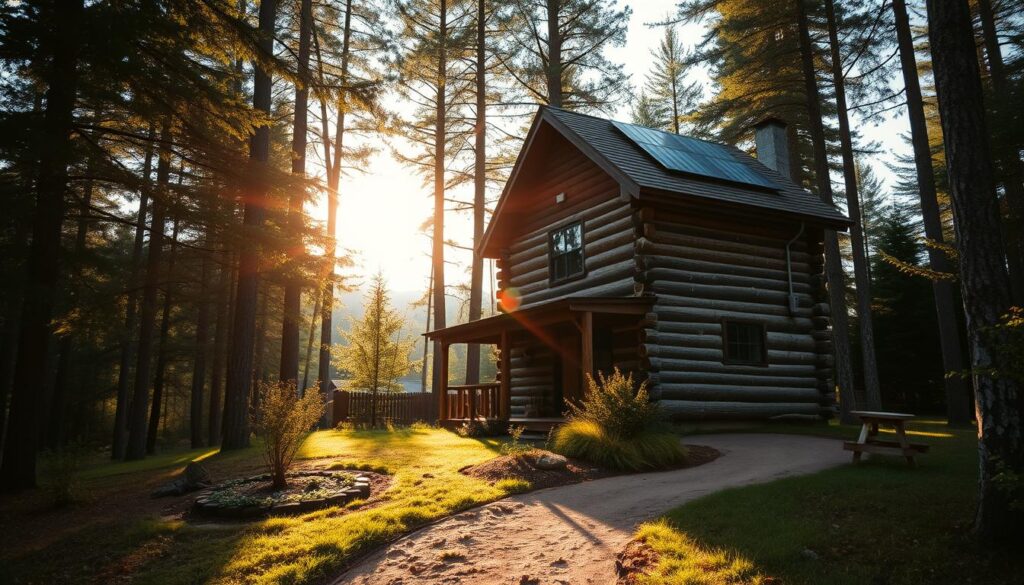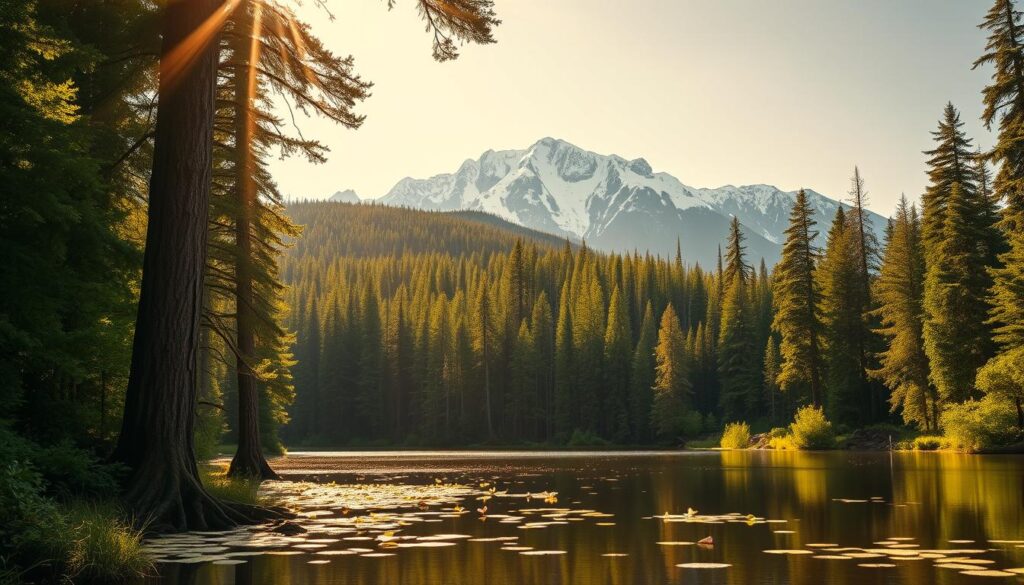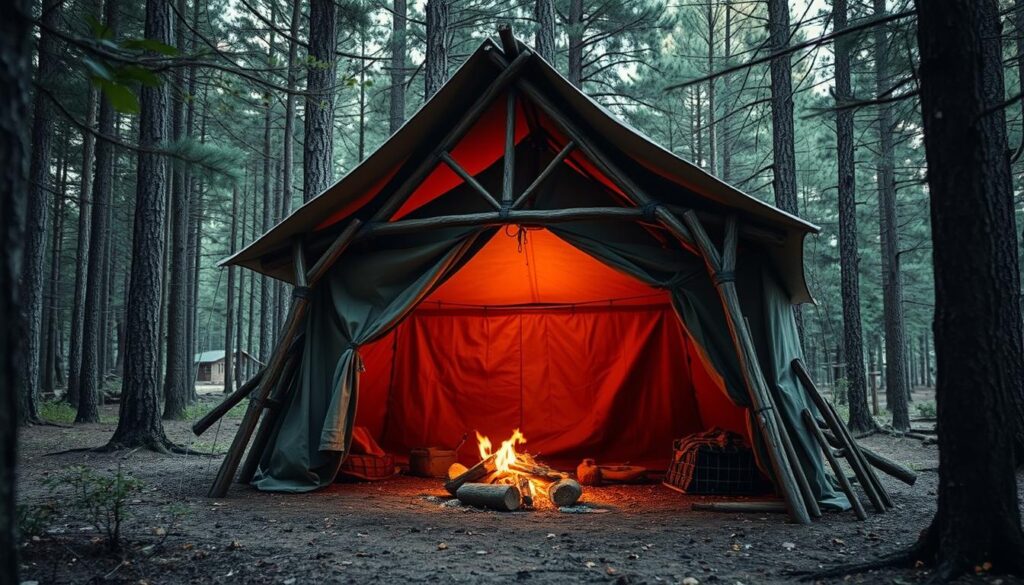As a former Air Force helicopter pilot, I’ve always sought adventure and challenge. This led me to start a journey to build my own sustainable living space. I did this with the help of my family.
Building my home was more than just a shelter. It was about living off the grid and staying true to my values. This journey has taught me a lot about being resilient and resourceful.
This experience has shown me what it really means to live sustainably. It’s also highlighted the value of DIY projects in making this lifestyle possible.
Key Takeaways
- Embracing a sustainable lifestyle through self-sufficiency
- The importance of family support in large DIY projects
- Lessons learned from building an off-grid home
- The value of resilience and resourcefulness in DIY endeavors
- Achieving a self-sufficient lifestyle through careful planning
Why I Chose to Build an Off-Grid Cabin
The idea of remote living without urban life’s limits drew me to an off-grid cabin. Planning my project showed me it’s more than a new place to live. It’s about living self-sufficiently.
My Motivation for Going Off-Grid
I wanted to live in harmony with nature. I aimed to cut down on public utilities and live sustainably. I believe off-grid living leads to a more fulfilling life, away from urban stress.
Living off the grid means gaining independence and self-reliance. This is hard to find in traditional living.
The Benefits of Off-Grid Living
Off-grid living helps reduce our environmental impact. Using renewable energy and sustainable water systems cuts down on our environmental footprint.
It also promotes a simpler life. We use resources wisely and waste less. This lifestyle is good for the planet and brings a sense of community and personal fulfillment.
- Reduced environmental impact
- Increased self-sufficiency
- A simpler, more mindful way of living
Building an off-grid cabin is more than just a home. It’s creating a self-sufficient retreat that reflects my values and dreams.
Choosing the Perfect Location for My Cabin
Starting my off-grid living journey, finding the right spot for my cabin was key. I had to weigh many factors to make sure my eco-friendly cabin was both green and fun.

Environmental Factors to Consider
First, I thought about how my cabin would affect the environment. I wanted a place where I could escape into nature without harming it. I looked at the land’s shape, soil, and water resources.
I made sure my cabin wouldn’t hurt local animals or cause soil erosion. By checking these things, I found a spot that was good for the planet and peaceful.
Accessibility and Resources
Next, I thought about how easy it was to get to the site and if I had what I needed. I looked at how close it was to important services, the road quality, and if I could find materials to build.
If you’re thinking about building an off-grid cabin, check out this guide for buying an off-grid cabin. It has tips on picking the best location and dealing with off-grid living challenges.
Designing My Off-Grid Cabin
When designing my off-grid cabin, I aimed for a space that’s both useful and eco-friendly. I thought about the layout, materials, and how to save energy. My dream was to make a sustainable living place that’s good for the planet and cozy.
Creative Design Ideas
I chose to use one material for the inside of my cabin. We covered it all in birch ply. This made building easier and gave the cabin a unified look. It also makes the space feel bigger.
Using birch ply inside has many pluses. It makes the cabin feel warm and inviting. Plus, it’s a green choice that fits with off-grid living.
Maximizing Space Efficiency
Designing my cabin to use space well was key. I picked a layout that’s both small and smart. For example, the living area also works as a workspace. The kitchen is designed to waste less.
I planned the layout carefully to make the cabin feel roomy. Adding loft storage and small furniture helped. This way, the cabin is both cozy and supports sustainable living.
Materials and Resources for Construction
Building my eco-friendly cabin was a journey of finding the right materials. It showed how important the choice of materials is. They affect the environment, cost, and efficiency of the cabin.
Choosing materials for an off-grid living space is key. I picked sustainable and eco-friendly options. For example, the fireplace came from someone’s garage, giving it a new life. The cladding was a last-minute choice but worked well.
Sustainable Building Materials
Sustainable materials help reduce environmental impact. I looked at:
- Reclaimed and recycled materials
- Locally sourced timber
- Low VOC paints and finishes
- Insulation from natural fibers
These materials made my self-sufficient retreat more energy-efficient. They also cut down on carbon emissions.
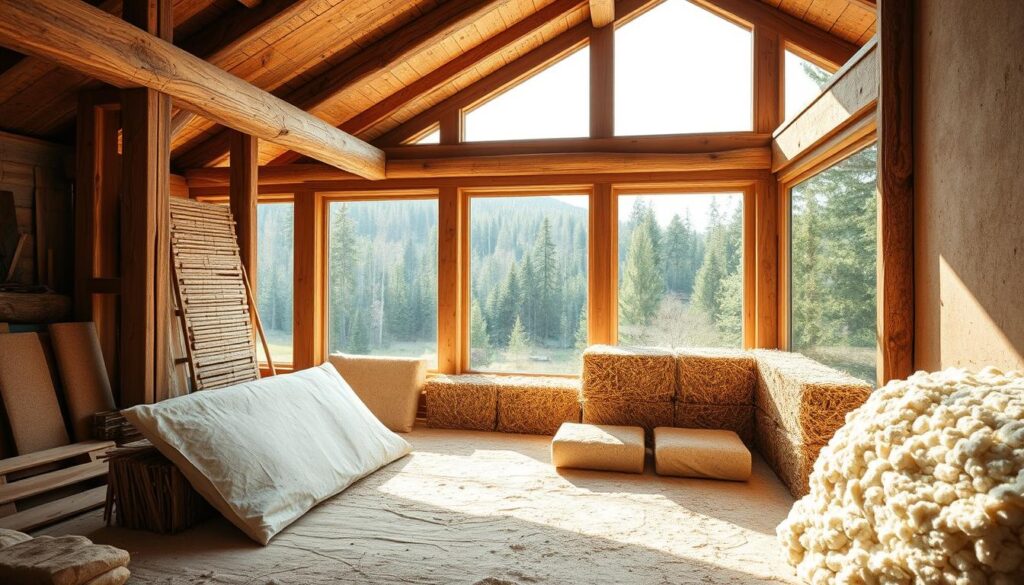
Budgeting for My Project
Budgeting was essential for my project. I wanted quality, sustainable materials but had to keep costs low. I found good deals by buying from local suppliers and salvage yards.
Being smart and flexible with materials helped me stay on budget. I built an eco-friendly off-grid cabin without breaking the bank.
Essential Utilities for Off-Grid Living
For those embracing the off-grid lifestyle, setting up the right utilities is key. Living off the grid means being self-sufficient. This requires reliable systems for water and energy.
One of the first steps in setting up your off-grid cabin is to establish a sustainable water system. This can involve various methods, including:
- Rainwater harvesting: Collecting and storing rainwater for various uses.
- Well or spring water: Utilizing natural sources of water.
- Water filtration systems: Ensuring that your water is clean and safe to drink.
Setting Up Water Systems
When it comes to water systems, having a reliable source and purification method is essential. Rainwater harvesting is a popular choice for off-grid homes. It’s sustainable and cost-effective. But, it’s important to have a proper filtration system to ensure the water is safe for consumption.
For instance, using a combination of sedimentation, filtration, and UV treatment can provide clean drinking water. It’s also worth considering the storage capacity to ensure you have enough water during dry periods.
Renewable Energy Sources
Renewable energy is at the heart of off-grid living. Solar power is one of the most popular choices. It’s abundant and the technology for harnessing it is advanced. Installing solar panels can provide a reliable source of electricity, reducing your reliance on fossil fuels.
Other renewable energy sources include wind and hydro power. The choice of energy source depends on your location and the resources available to you. For example, if you’re in a windy area, wind turbines could be a viable option.
Some key considerations when setting up renewable energy systems include:
- Assessing your energy needs to determine the size of the system required.
- Choosing the right equipment, such as solar panels or wind turbines.
- Ensuring proper installation to maximize efficiency and safety.
By focusing on these essential utilities, you can create a sustainable and self-sufficient off-grid living experience. Whether it’s through rainwater harvesting or solar power, the key is to be mindful of your consumption and to use resources wisely.
The Construction Process: Step-by-Step
Building my off-grid cabin was a journey of discovery. It involved many steps from foundation to completion. It was challenging but rewarding, needing careful planning and execution.
Looking back, spending twice as much and taking twice as long as hoped is common for such projects. But the end result was worth the challenges.
Building the Foundation
The first major step was building the foundation. This involved clearing the land, preparing the site, and laying the foundation. I chose a slab-on-grade foundation for its simplicity and cost-effectiveness.
Planning was key to ensure the foundation was level and secure. Specialized equipment and techniques were used to prepare the ground and lay the slab.
| Foundation Type | Cost | Complexity |
|---|---|---|
| Slab-on-Grade | $10,000 | Moderate |
| Crawl Space | $15,000 | High |
| Full Basement | $20,000 | Very High |
Framing the Structure
After the foundation was set, framing the structure began. This involved building the walls and roof using locally sourced timber.
Framing is key as it shapes and strengthens the cabin. I combined traditional framing with modern materials for durability and sustainability.
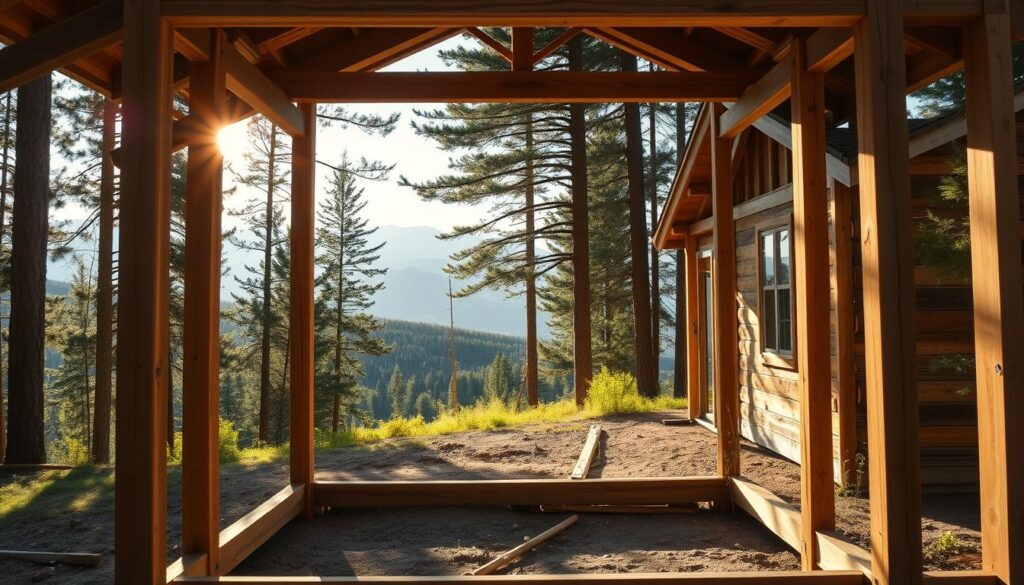
Completing the Interior
The final step was finishing the interior. This included installing insulation, drywall, flooring, and finishes like painting and trim work.
I chose sustainable materials and energy-efficient solutions to reduce the cabin’s environmental impact. The result is a cozy, functional space that embodies the spirit of an off-grid cabin for those who love escaping into nature.
Challenges I Faced During Building
My journey to create a self-sufficient retreat was filled with obstacles. Building an off-grid cabin is a big task. It’s key to be ready for the challenges it brings.
One big hurdle was weather-related setbacks. The wettest season in years surprised me. I had to clean mold off plywood that wasn’t sealed in time. This taught me to prepare for extreme weather and seal materials quickly.
Weather-Related Setbacks
Weather can greatly affect building. I faced issues like:
- Delays from heavy rain
- Mold on unsealed materials
- Hard work in extreme weather
To avoid these problems, check your area’s weather history. Use weather-resistant materials and have a backup plan to reduce delays.
Sourcing Materials
Finding the right materials for my off-grid cabin was tough. I wanted materials that were good for the planet and off-grid living. But, this caused delays and extra costs.
Some problems I had with materials were:
- Finding suppliers of sustainable materials
- Managing the cost of off-grid materials
- Choosing materials that last in our climate
To solve these issues, look for local suppliers. Consider other materials and think about the long-term benefits of quality, sustainable ones.
Living Off the Grid: Daily Routines
Living off the grid has changed me, making me think about every action. My days are now about saving resources and being efficient.
Managing Energy Consumption
It’s key to use less energy in an off-grid cabin. I’ve found ways to cut down. For example, I choose appliances that use less power and turn off things I’m not using.
I keep an eye on how much energy I use every day. I use a system to track how much power my solar panels make and how much is stored in my batteries. This lets me adjust how much energy I use.
| Device | Energy Consumption (Watts) | Usage Frequency |
|---|---|---|
| LED Lights | 9 | Daily |
| Laptop | 65 | Daily |
| Refrigerator | 120 | Continuous |
Food and Water Storage Solutions
Storing food and water well is key to living off the grid. I collect rainwater for drinking, cooking, and other needs. This water comes from a system I set up.
I store food in a root cellar for veggies and fruits. I also have a solar-powered fridge for keeping food fresh.
It’s also important to save water. I’ve put in low-flow showerheads and toilets to use less water.
By paying attention to my daily habits and using smart systems, I’ve thrived in my off-grid cabin. It’s a journey of learning, but it’s made me closer to nature and more sustainable.
Tips for Future Off-Grid Cabin Builders
Building an off-grid cabin has changed me, and I want to share what I’ve learned. Preparation is key to a successful project.
Having the right tools and equipment is critical for off-grid cabin construction. A well-prepared toolkit can greatly improve your work’s efficiency and quality.
Essential Tools and Equipment
For building an off-grid cabin, the right tools are essential. Some must-haves include:
- A reliable drill and bits for various tasks
- A circular saw for cutting lumber
- A hammer and tape measure for framing and measuring
- A level to ensure your structure is properly aligned
- Safety gear, such as gloves and goggles, to protect yourself
If you’re interested in off-grid cabin plans, check out Jackery’s Off-Grid Cabin Plans for inspiration and guidance.
Learning from My Mistakes
During my project, I faced many challenges that taught me valuable lessons. Flexibility and patience are key. Off-grid living is more than building a cabin; it’s embracing a lifestyle that requires adaptability and resilience.
“It’s never as good as Instagram makes it look. We post the good days and the milestone moments.”
This quote really hits home. It shows the reality of off-grid living. Social media often shows a perfect version of off-grid life, but the truth is it’s filled with challenges and rewards.
In conclusion, building an off-grid cabin is rewarding but requires careful planning, the right tools, and learning from mistakes. Being prepared and flexible can help you create a sustainable and fulfilling off-grid lifestyle.
Reflecting on My Off-Grid Journey
As I sit in my off-grid cabin, surrounded by nature’s calm, I feel truly fulfilled. Building this cabin was more than just a shelter. It was about living sustainably and escaping into nature.
A Life of Self-Sufficiency
Living off the grid has been incredibly rewarding. I’ve learned to use renewable energy and manage my water. My cabin shows the beauty of living in sync with nature.
Future Aspirations
I’m excited to keep improving my off-grid setup and find new ways to be eco-friendly. My journey is ongoing, and I love sharing what I’ve learned. My cabin’s story is one of change, growth, and connecting with nature.
FAQ
What inspired you to build an off-grid cabin?
I wanted to live more sustainably and be self-sufficient. Building an off-grid cabin let me do that. It’s a way to escape into nature and use less public utilities.
How did you choose the perfect location for your off-grid cabin?
I looked at the climate, soil, and natural resources. I also thought about how easy it was to get there and if there was sunlight and wind for energy.
What are some key considerations when designing an off-grid cabin?
I aimed to use space wisely and be creative. I chose sustainable materials to make it eco-friendly and functional.
What are the essential utilities needed for off-grid living?
You need good water systems like wells or rainwater harvesting. Renewable energy like solar or wind power is also key. They help you use energy well.
What were some of the challenges you faced during the construction process?
Weather, finding materials, and other issues were tough. But I learned to be resourceful and adapt.
How do you manage energy consumption in your off-grid cabin?
I use energy-efficient appliances and make the most of my renewable energy. I’m also careful with how much energy I use every day.
What tips would you offer to individuals planning to build their own off-grid cabins?
Be ready for challenges, have the right tools, and be open to learning. This will help you succeed with your off-grid project.
How has living off the grid impacted your daily life?
It’s made me more self-sufficient and appreciative of resources. I feel more connected to nature and fulfilled.
What are some of the benefits of living in an eco-friendly, solar-powered cabin?
My cabin uses less fossil fuel, cuts energy costs, and is healthier. It’s a big step towards sustainable living.
What advice would you give to someone looking to start their own off-grid journey?
Start small, be patient, and be ready to learn and adapt. Think about your resources, budget, and goals before starting.

